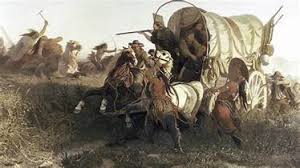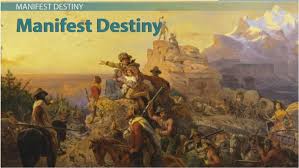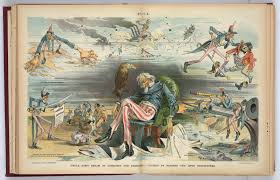Manifest Destiny: A Historical Overview
Manifest Destiny, a term coined in 1845, encapsulates the belief in the inevitable expansion of the United States westward to the Pacific Ocean and beyond. This ideology played a crucial role in shaping U.S. territorial acquisitions before and after the American Civil War. It was a concept deeply rooted in the American psyche, justifying the annexation of vast lands and shaping foreign policy decisions well into the late 19th century.
Origins and Early Expansion
John L. O’Sullivan, a Democratic Party magazine editor, first introduced the phrase “Manifest Destiny” in 1845 while advocating for the annexation of Texas and American expansion. Although O’Sullivan’s initial mention was a mere complaint against European interference, his later writings imbued the term with a sense of divine mission, suggesting that American expansion was preordained by Providence.
During the 19th century, this belief fueled the acquisition of territories such as Oregon, Texas, New Mexico, and California. The Louisiana Purchase in 1803 and subsequent treaties and wars, including the Mexican-American War (1846-1848), dramatically increased U.S. landholdings, stretching from the Atlantic to the Pacific.
Manifest Destiny and Controversy

Despite its widespread appeal, Manifest Destiny was not without its critics. The Whig Party, for instance, derided the concept as belligerent and arrogant, while notable figures like Massachusetts Rep. Robert Winthrop used the term mockingly. Yet, it resonated with many Americans who saw it as a justification for their expansionist desires.
The relentless push westward often led to conflicts and displacement of Native American tribes. Policies like President Andrew Jackson’s Indian Removal Act of the 1830s resulted in tragedies such as the Trail of Tears, highlighting the human cost of this expansionist ideology.
The Civil War and a Brief Hiatus
The Civil War (1861-1865) temporarily stalled the expansionist fervor as the nation grappled with internal divisions. However, the idea resurfaced briefly with the purchase of Alaska in 1867. The period also saw increased interest in establishing American influence overseas, exemplified by the annexation of Hawaii and the Spanish-American War in the 1890s.
The New Manifest Destiny
By the late 19th century, the United States had emerged as a burgeoning industrial power. Influenced by naval strategist Alfred Thayer Mahan’s ideas on sea power, America pursued a “New Manifest Destiny,” focusing on overseas expansion. This era saw the U.S. acquiring territories like Puerto Rico, Guam, and the Philippines, signaling a shift from continental to global ambitions.
Conflicting Views and Legacy
Historians have long debated the origins and implications of Manifest Destiny. Frederick Jackson Turner’s 1893 essay suggested that the frontier shaped American character and exceptionalism. However, later scholars, known as New Western Historians, challenged this view, emphasizing the role of government and corporations in dispossessing indigenous peoples and questioning the notion of American exceptionalism.
Causes and Effects of Manifest Destiny
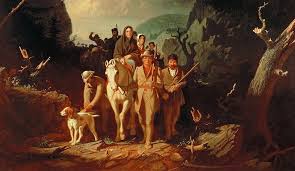
Manifest Destiny, a term coined in the mid-19th century, encapsulated the belief that the United States was destined by Providence to expand its territory across North America. This doctrine had profound causes and far-reaching effects, shaping the history and development of the United States.
Causes of Manifest Destiny
Westward Expansion
The drive for westward expansion was ingrained in American culture from the earliest colonial days. English settlers who colonized North America were determined to conquer the vast wilderness to the west, driven by a desire for new land and opportunities.
The Louisiana Purchase
In 1803, President Thomas Jefferson’s Louisiana Purchase doubled the size of the United States, igniting a fervor for westward movement. This massive acquisition of land spurred settlers to venture beyond the original colonies, seeking new opportunities and fueling the belief in Manifest Destiny.
Government Intervention and Territorial Annexation
As settlements spread along the country’s borders, friction with neighboring territories and indigenous populations increased. The U.S. government often intervened, leading to the annexation of additional territories. This expansionist policy was seen by many Americans as a divine mission to extend the nation’s boundaries.
Divine Providence
Many Americans believed that it was God’s will for the country to expand. This sense of divine mission provided a moral justification for the pursuit of Manifest Destiny, reinforcing the idea that the United States was destined to spread its values and civilization across the continent.
Influence of Government and Corporations
Historians have highlighted the significant role played by the government and powerful corporations in the pursuit of land and resources. These entities had the capability to overwhelm indigenous populations and secure vast territories for settlement and economic exploitation.
Military Strength
The late 19th century saw a resurgence of Manifest Destiny, driven by the United States’ growing military strength. This second wave of expansion extended American influence beyond the continental borders, further solidifying the nation’s imperial ambitions.
Effects of Manifest Destiny
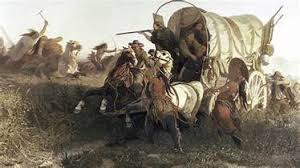
Territorial Expansion
By the end of the Mexican-American War in 1848, the United States had extended its sovereignty from the Atlantic to the Pacific Ocean and from the 49th parallel on the Canadian border to the Rio Grande in the south. This expansion fulfilled the vision of a transcontinental nation.
Impact on Indigenous Populations
The westward expansion had devastating effects on indigenous populations. Armed conflict, forced relocation, and the encroachment of settlers led to significant suffering and displacement of Native American communities.
Settlement and Development
The sparsely populated western regions were rapidly settled by hundreds of thousands of Americans. These settlers established new communities, contributing to the nation’s growth and development. The new territories provided access to vast natural resources and opportunities for economic expansion.
Access to Resources and Trade
The acquisition of new territories gave the United States access to greater natural resources and opened up the Pacific trade routes. This economic boon helped propel the nation’s industrial growth and increased its global influence.
Revival of the Slavery Debate
The expansion into new territories reignited the contentious debate over slavery. The question of whether new states would permit slavery exacerbated sectional tensions and ultimately contributed to the outbreak of the American Civil War in 1861.
Overseas Expansion
The second wave of Manifest Destiny in the late 19th century led to the American acquisition of territories beyond continental North America. This period saw the United States asserting its influence in regions such as Hawaii, Puerto Rico, Guam, and the Philippines, marking the country’s emergence as a global power.


